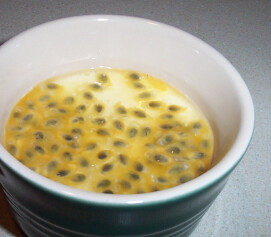
Originally, I had intended to write this post to participate in the
Spice is Right II foodblogging event. Then last night, mere hours before the deadline, I read the rules and found out that my recipe was ineligible for inclusion, because I used a herb instead of a spice. But that doesn't mean I can't post about the results anyway!
The theme of the event was "Sweet or Savory," and was based on the idea that, in certain cultures, some spices are used primarily in sweet dishes (e.g., cinnamon in most of Western European culture) and some in savory foods. The challenge was to take one of these assumptions and turn it on its head, by using a "sweet" spice in a savory dish or vice versa. (This isn't a tremendous challenge for me any more, since I have been dabbling in Moroccan cuisine for a few years now, which liberally uses cinnamon - not to mention sugar - in its savory dishes.)
For the event, my mind immediately went to one place: the vanilla panna cotta with basil syrup and passionfruit that is the signature dessert at Montreal's
Brunoise. I was really impressed with it at the time, because the idea of using basil in a dessert seemed pretty unusual. But one bite and I was convinced. It was astonishing how well the basil paired with the passionfruit; it was almost as though they were one seamlessly integrated flavour. So I decided I would try to recreate the dessert at home.
You know how, some days, you just don't have kitchen karma? Yesterday was one of those days for me. First, the pizza I was making for dinner was giving me all sorts of trouble. Then, as I was struggling to roll out the dough, my husband walked into the kitchen and said, "What's this green thing?"
"It's basil syrup, for dessert," I replied.
"But it's solid."
Sure enough, it was. My basil syrup, a wonderful little super-structure solution of water, sugar and basil essential oils, had crystallized.
Everything else was ready, though, so I diluted some of the still-liquid part of the syrup and served the dessert anyway. The fact that it was only my husband and I eating it helped in that respect.
Despite the problems with the syrup, I liked the way it turned out. Naturally, the balance of flavours wasn't as good as it was at the restaurant, but it was a good starting point. The appearance was a little off-putting: my husband said it look "like a pond" (with the passionfruit seeds as tadpoles) and the basil syrup was slightly crunchy and insufficiently green. But the flavour was pretty good, despite my having used inferior vanilla and basil.
I left the remainder of the syrup overnight, and this morning it had completely crystallized, leaving me with basil candy instead of basil syrup. So this evening, I melted it in the microwave, diluted it with water, and cooled it off, and this time, it worked.
And there are worse fates than having panna cotta with basil syrup and passionfruit two nights in a row.
Panna cotta with basil syrup and passionfruitNote that I provide these recipes for reference only. I'm including this disclaimer because the basil syrup didn't really work.
For the panna cotta1 3/8 tsp. gelatin
1 Tbsp. cold water
1 cup heavy cream
1/2 cup half-and-half
2 Tbsp. + 2 tsp. sugar
1 vanilla bean, split and scraped
For the basil syrup3 or 4 sprigs basil
1/2 cup sugar
1/2 cup water
1 passionfruit
1. Make the panna cotta: In a small bowl, sprinkle the gelatin over the water to soften. In a pot, mix the heavy cream, half-and-half, sugar and vanilla bean and bring just to a boil over medium-high heat, stirring to dissolve the sugar. Transfer some of the cream mixture (say, 1/4 cup) to the bowl with the gelatin, and stir to dissolve. Transfer the cream-gelatin mixture back to the pot, and stir. Remove the vanilla bean. Divide the contents among four ramekins, leaving space for the syrup and passionfruit. Cover with plastic wrap and cool to room temperature (about 30 minutes). Transfer to the fridge and chill until set, about 4 hours.
2. Make the basil syrup: combine all ingredients in a small pot, bring to the boil, stirring to dissolve the sugar. Boil for 10 minutes to infuse. By following these directions, you might end up with basil candy too, so it might be a good idea to cover the pot while infusing and/or increase the water content to, say, 3/4 cup. Cool the syrup.
3. To serve, pour some of the cooled basil syrup over the panna cotta (still in the ramekins). Halve the passionfruit, and scrape out the pulp, dividing between the ramekins. Enjoy!
Serves 4
